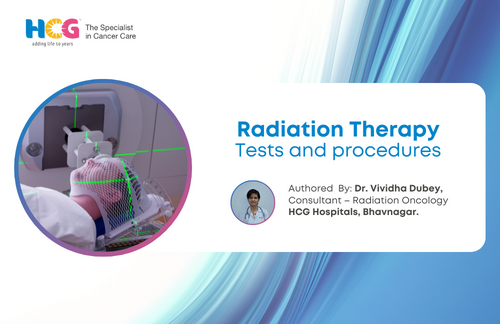
13 Nov, 2025
Feel free to reach out to us.

13 Nov, 2025

This article is medically reviewed by Dr. Pranav Shah, Consultant – Radiation Oncology, HCG Cancer Centre, Vadodara.
Radiation therapy procedure is a type of cancer treatment that uses beams of intense energy to kill cancer cells. Radiation therapy most often uses X-rays, but protons or other types of radiation can also be used.
Radiation therapy procedures can be teletherapy (external beam) or brachytherapy (internal beam).
In teletherapy, high-energy beams come from machines positioned at a certain distance from the body during radiation. In brachytherapy, the radiation source is placed inside the body, very close to the tumor.
The radiation beams damage cancer cells by destroying the genetic material that controls how they grow and divide.
Depending on the type of cancer and various individual patient parameters, radiation therapy may be used alone or in combination with other treatments to control cancer growth.
In this article, we are discussing several aspects of radiation therapy, starting with what it is, its role in managing cancer, and how it is administered. This article will also help you understand what to expect from radiation treatments.
Radiation therapy procedure uses high-energy radiation to kill cancer cells or stop their growth.
The goal of radiation therapy may vary from one case to another and may commonly include reducing tumor size, destroying malignant cells, and relieving cancer symptoms.
Radiation damages cells' DNA and stops their ability to replicate and grow.
Radiation therapy uses high-intensity energy beams to target and destroy cancer cells while minimizing
damage to healthy tissue. It's a vital tool in cancer treatment, offering precise and effective
solutions that contribute to improved outcomes and quality of life for patients undergoing treatment.
Dr. Pranav Shah
Precise treatment planning is crucial to minimize damage to surrounding healthy tissues.
At the time of treatment planning, specialists carefully determine the size, shape, and exact location of the tumor to plan the radiotherapy type, radiation dose, and number of radiation sessions.
Radiotherapy may be administered in combination with other treatment options, namely surgery, chemotherapy, or immunotherapy, to improve the overall effectiveness of the treatment.
The following are the two types of radiation therapy procedures:
One of the most common types of radiation treatment used in the management of cancer is external beam radiation therapy.
High-energy beams of radiation—by a machine—are directed at the tumor from outside the body. The goal is to kill the cancer cells while minimizing damage to the healthy tissues surrounding the tumor.
Advanced imaging techniques, such as CT or MRI scans, detect the precise location of the tumor.
Treatments are usually given in several sessions, allowing higher total radiation doses to be safely given. EBRT is non-invasive and often used to treat different types of cancer, including brain, breast, lung, and prostate cancers.
Internal radiation therapy, or brachytherapy, is a cancer treatment where radioactive material is placed directly inside a tumor or surrounding tissue.
It allows for delivering high doses of radiation to cancer cells while minimizing exposure to the healthy tissues surrounding them.
Selective internal radiation therapy is primarily used to treat malignancies in the prostate, cervix, uterus, and breast.
Radiation therapy is one of the pillars of cancer treatment. It is a non-invasive treatment approach, wherein
powerful energy beams are used to destroy cancer cells by damaging their DNA structure.
There are two types of radiation therapy, based on how the radiation beams are delivered: external beam
radiation therapy and internal beam radiation therapy.
he goal of a radiation therapy procedure may vary from one patient to another, and it depends on multiple individual case parameters. The following are the different goals of administering radiation treatments:
Radiation therapy treatment has been quite effective in treating early-stage cancers. Targeted radiation beams destroy cancerous cells with minimal damage to healthy tissues.
For cancers in their early stages, radiation can either be the primary mode of treatment or used with surgery to ensure that all the cancer cells are killed. Advanced imaging techniques increase accuracy and thereby reduce side effects.
Early intervention with radiation therapy can be offered in many instances, with an extremely high success rate.
Radiation oncology treatment plays a significant role in preserving organs when used alone or in conjunction with chemotherapy in cancers of the oropharynx/hypopharynx (throat) or larynx (voice box).
Radiation therapy may also be administered in combination with surgery. For instance, breast conservation surgery, wherein cancerous tissue is removed along with a small portion of healthy tissue, is often followed by radiotherapy to destroy the residual cancer cells.
Radiation oncology treatment plays a significant role in preventing the recurrence of cancer, especially after primary treatment like surgery.
For example, post-operative radiation therapy targets any residual cancer cells that may be left behind, reducing the chances of cancer recurrence.
Radiation treatment for cancer works quite well for cancers with local recurrences, such as breast, head, neck, and anorectal cancers. Advanced techniques guide the accuracy of treatments to ensure minimal damage to surrounding healthy tissues.
Radiation therapy may also be recommended to alleviate or relieve symptoms that result from advanced cancers. It reduces pain, shrinks tumors, relieves pressure or obstructions on affected organs, and increases the quality of life.
Nearly 60% of cancer patients will need radiotherapy alone or in combination with other treatments, like surgery and chemotherapy. This makes radiotherapy one of the pillars of cancer treatment.
Depending on the case parameters, the goal of radiotherapy may vary. It may be to destroy the tumor completely, to shrink the tumor, to kill the residual cancer cells, and alleviate pain and discomfort experienced terminal stages.
Dr. Pranav Shah
Radiation therapy is also recommended for the management of recurrent cancer after locating the re-grown cancerous cells after primary treatment and killing them.
In cases of local recurrence, radiation can be precisely delivered to the site of recurrence, thereby limiting damage to the adjacent normal tissues.
Combining radiation with other modalities of treatment, such as chemotherapy, may improve results.
Radiation treatment is an important option in the management of recurrent cancer. It prolongs survival by delaying disease progression and alleviating symptoms.
Following are the steps in the radiation therapy procedure:
External beam radiation therapy usually uses a linear accelerator, which directs high-energy radiation beams into the body.
As you lie on a table, the linear accelerator moves around you to deliver radiation from several angles. The linear accelerator can be adjusted to your situation to deliver a precise radiation dose and achieve the maximum dose delivery effect.
You typically receive external beam radiation on an outpatient basis five days a week over a certain period. In most instances, treatments are usually spread over several weeks to allow your healthy cells to recover between radiation therapy sessions.
Sometimes, a single treatment may help relieve pain or other symptoms associated with more advanced cancers.
You will lie still and breathe normally during the treatment, which takes only a few minutes. For some patients with lung or breast cancer, you might be asked to hold your breath while the machine delivers the treatment.
Your radiation therapy team stays nearby in a room with video and audio connections so that you can talk to each other. You should speak up if you feel uncomfortable, but you should not feel any pain during your radiation therapy session.
The main steps involved in radiation therapy are consultation, simulation, treatment planning, treatment delivery, and follow-up care.
During each step, the expert team will have a detailed discussion with the patient to help them understand what to expect during those steps. This way, the patient is very much involved in the decision making and has better control over their care journey.
The risks and side effects associated with radiation therapy depend on several factors, such as dose, types of radiation therapy, the site of the tumor, and the overall health of the patients.
Some of the common radiation therapy side effects are fatigue, nausea or vomiting, loose or frequent stools, frequent urination, and trouble swallowing.
| Parts of the body being treated | Side effects |
|---|---|
| Brain | Hair loss, memory or concentration problems, headache, and blurry vision |
| Chest | Skin changes, throat problems, such as trouble swallowing, coughing, and shortness of breath |
| Breast | Skin changes, swelling (edema), and tenderness |
| Head and Neck | Mouth problems, taste changes, and less active thyroid gland |
| Stomach | Diarrhea, nausea and vomiting, and urinary and bladder problems |
| Rectum and Pelvis | SSexual problems, fertility problems, and urinary and bladder problems |
If you're receiving radiation for a tumor, your doctor may have you undergo periodic scans after your treatment to see how your cancer has responded to radiation therapy.
Even after the completion of treatment, regular follow-ups and periodic scans are done to ensure tumor control. The aim of radiation treatment, be it curative or palliative, and the response to treatment depend on the presentation stage at the treatment time.
At HCG, a single-specialty cancer hospital in India, we have a department dedicated to offering full-fledged radiation oncology services. It is fully equipped with advanced technology expertise and a multidisciplinary team with highly competent radiation oncologists, radiologists, central physics specialists, and support staff.
It designs treatment plans precisely to meet the required needs. It ensures that treatments are effectively administered with minimal side effects. HCG has the highest standards of treatment accuracy and safety.
Supported by advanced imaging, simulation, and quality assurance protocols, HCG believes in delivering excellent radiation oncology care to its patients, thus ensuring exceptional treatment outcomes.
External beam and internal beam radiation therapy are the two most common modalities used in cancer treatment.
Radiation therapy, apart from being a primary treatment, may also be used with chemotherapy and surgery to increase the overall effectiveness of the treatment. In addition, it decreases recurrence rates, relieves symptoms in cases of certain advanced cancer types, and treats recurrences.
Treatment plans work out the ideal radiation dosage so that the proper amount is given to have maximum effect with minimum side effects.
Follow-up sessions provide data for recovery and handling side effects after treatment, thus optimizing long-term health and quality of life.
Radiation Therapy for Cancer - NCI
What is Radiation Therapy? | IAEA
Radiation Therapy - StatPearls - NCBI Bookshelf

Author Bio : Dr. Pranav Shah
Consultant – Radiation Oncology
MBBS, MD (Radiation Oncology)
Dr. Pranav Shah is a distinguished radiation oncologist practicing at HCG Cancer Centre, a leading single-specialty cancer hospital in Vadodara. His specialization includes CNS malignancies, head and neck cancers, lung, GI, GU, gynecological cancers, and sarcomas. Additionally, Dr. Shah adeptly handles benign conditions like meningioma, acoustic neuroma, keloid, trigeminal neuralgia, and more. Highly skilled in neuro-oncology, he excels in performing stereotactic radiation techniques such as SRS and SABR, along with image-guided brachytherapy. Dr. Shah possesses comprehensive knowledge of DIBH (Deep Inspiration Breath-Hold) techniques in treating breast and lung cancers, as well as cranio-spinal irradiation procedures. With a diverse range of capabilities, Dr. Pranav Shah provides top-notch care and treatment for patients across various medical conditions, ensuring the highest standards of medical care.
To book an appointment with Dr. Pranav Shah, please click here.